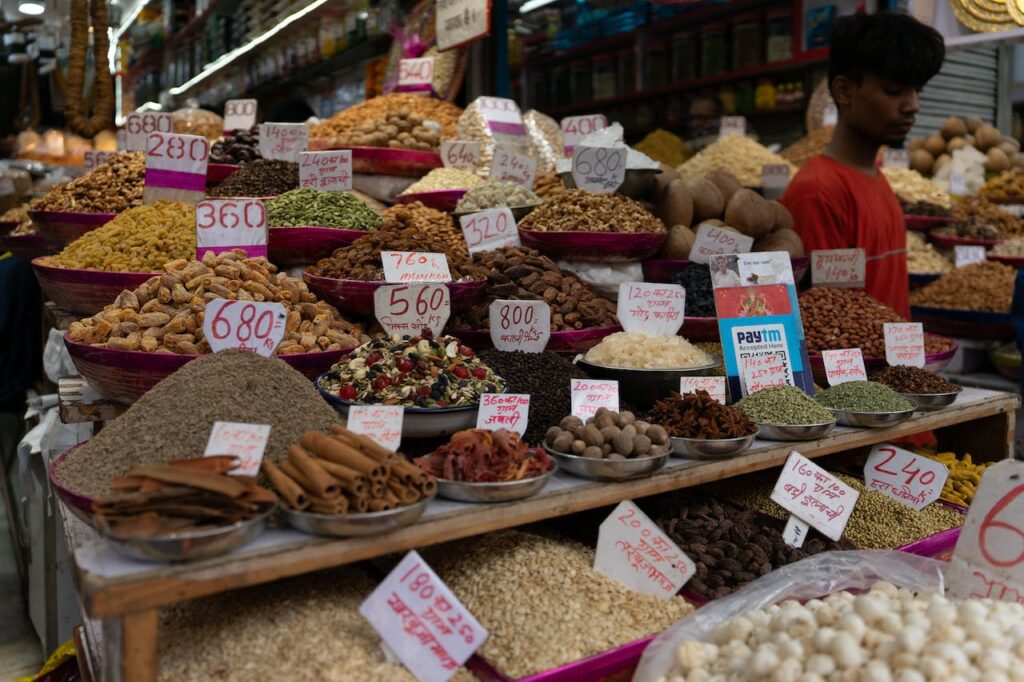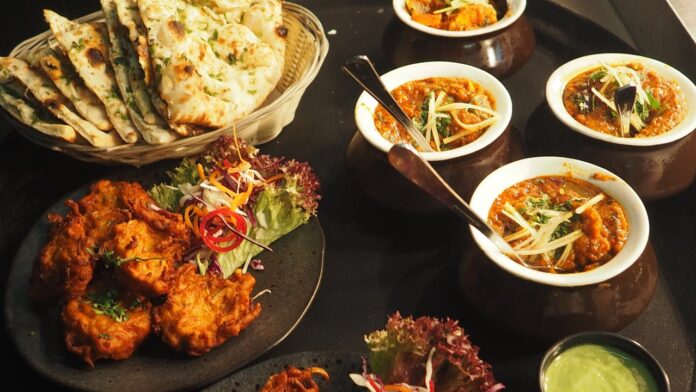India is a land of diverse cultures, languages, and traditions. But if there’s one thing that unites this incredible subcontinent, it’s the love for food. Indian cuisine is a magnificent tapestry of flavors, colors, and aromas that has captivated taste buds around the world for centuries. Join us on a culinary journey through the heart of India, as we explore the rich and diverse gastronomic wonders of this fascinating country.
Page Contents
The Diversity of Indian Cuisine
When it comes to Indian cuisine, the word ‘diversity’ takes on a whole new meaning. India is a vast country with 28 states, each offering a unique culinary experience. From the fiery curries of the south to the delectable sweets of the north, and the vegetarian delights of the west to the seafood feasts of the east, Indian food is a never-ending adventure.
North India: Start your culinary journey in the North, where you’ll find the rich, aromatic flavors of Punjabi cuisine. Indulge in dishes like butter chicken, biryani, and tandoori kebabs. Don’t forget to try the famous chaats of Delhi, and wash it all down with a glass of sweet, spiced chai.
South India: Head south to experience the fiery and tangy flavors of Andhra and Kerala cuisine. Savor dosas, idlis, and uttapams, while also exploring the world of seafood delicacies. Coconut-based curries and a variety of chutneys will dance on your taste buds.
East India: In the east, you’ll find an abundance of delicious seafood dishes. Bengali cuisine is famous for its mouthwatering sweets, especially the syrupy delights of rasgulla and sandesh. But it’s the spicy fish curries and delectable sweets that truly steal the show.
West India: Moving westward, you’ll encounter the robust flavors of Gujarat and the spicy richness of Maharashtra. The streets of Mumbai offer an irresistible range of street food, including vada pav and pav bhaji. Enjoy the hearty and diverse thalis in Gujarat, which can include sweet, savory, and spicy items on a single platter.
Central India: Central India introduces you to the traditional dishes of Madhya Pradesh and Chhattisgarh. The cuisine here is characterized by its simplicity and the use of locally sourced ingredients. Don’t miss the traditional dal baati churma and poha, a breakfast staple made from flattened rice.
Spices: The Heart of Indian Cooking
Indian cuisine is renowned for its bold and diverse use of spices. The careful balance of these spices is the secret behind the depth of flavor and complexity that Indian dishes offer. Some of the essential spices that are a cornerstone of Indian cooking include:
Turmeric: Known for its vibrant yellow color, turmeric is not only a flavor enhancer but also has numerous health benefits.
Cumin: Cumin seeds add an earthy and slightly nutty flavor to many dishes, making it a staple spice in Indian cuisine.
Coriander: Whether in the form of ground coriander or fresh cilantro leaves, this spice lends a refreshing citrusy note to dishes.
Cardamom: This spice brings a sweet and floral aroma to both sweet and savory dishes. It’s a key ingredient in chai and various desserts.
Cinnamon: Used in both whole and ground forms, cinnamon adds warmth and sweetness to many Indian curries and sweets.
Cloves: With their intense, aromatic flavor, cloves are often used in rice dishes, pickles, and certain curries.
Red Chilies: India loves its heat, and red chilies in various forms, from powder to whole, are used to add spiciness to dishes.
Mustard Seeds: These seeds are frequently tempered in hot oil at the beginning of cooking to release their nutty flavor and aroma.
The combination of these spices, along with others, creates the incredible depth of flavor that Indian cuisine is celebrated for.

Street Food: An Adventure for the Senses
One of the most exciting ways to explore Indian cuisine is by diving into the world of street food. The streets of India are bustling with vendors offering a wide array of delicious and affordable treats. Let’s take a tour of some of the most famous street foods you must try.
Pani Puri/Golgappa: These crispy hollow spheres, filled with spicy tamarind water, potato, and chickpeas, are a favorite street food all over India. They burst with a mix of sweet, sour, and spicy flavors.
Chaat: A collective term for various savory snacks, chaat includes dishes like aloo tikki chaat, dahi puri, and bhel puri. These are a delightful combination of crispy, crunchy, and tangy.
Vada Pav: Often referred to as the Indian burger, vada pav features a spicy potato fritter served in a bun. It’s a popular snack in Mumbai.
Samosa: The iconic triangular pastry filled with spiced potatoes or meat is enjoyed all over the country. Pair it with tamarind chutney for the perfect snack.
Kathi Roll: A specialty of Kolkata, these rolls are made by wrapping spicy fillings like kebabs, eggs, or chicken in a flatbread. They’re portable and perfect for on-the-go snacking.
Dabeli: Hailing from Gujarat, Dabeli is a spicy potato mixture served within a pav, garnished with pomegranate seeds and roasted peanuts.
The Art of Indian Sweets
No journey through India’s culinary wonders is complete without indulging in its delightful array of sweets. Indian sweets, also known as mithai, are a class of their own, with each region having its unique creations. Here are some of the most beloved Indian sweets:
Gulab Jamun: These golden, syrup-soaked milk dumplings are a staple at celebrations. They are soft, sweet, and melt in your mouth.
Jalebi: These orange spirals of deep-fried dough soaked in sugar syrup are a popular treat all over India. They are crunchy, sweet, and slightly tangy.
Rasgulla: Hailing from West Bengal, rasgullas are spongy, white cheese balls soaked in a fragrant sugar syrup. They are a classic example of Indian dessert perfection.
Barfi: These sweet, fudge-like confections come in a variety of flavors, such as plain, pistachio, almond, and cashew. They are often garnished with silver leaf for a touch of opulence.
Ladoo: Ladoos are round, sweet balls made from ingredients like gram flour, semolina, and crushed nuts. They are often prepared during festivals and special occasions.
Rasmalai: A delightful Bengali dessert, rasmalai consists of soft cheese dumplings in a creamy, saffron-infused milk syrup.
Regional Specialties
Every region of India boasts its own unique culinary traditions, and exploring these specialties is like embarking on a gastronomic adventure. Here are a few regional dishes that you must try:
Dum Biryani (Hyderabad): This fragrant and flavorful rice dish is cooked with succulent pieces of meat, marinated in spices, and slow-cooked in a sealed pot. It’s a must-try for biryani enthusiasts.
Dhokla (Gujarat): A light and fluffy snack made from fermented rice and chickpea flour, dhokla is a healthy, savory treat, often served with mint and tamarind chutneys.
Sorshe Ilish (Bengal): This delectable Bengali dish features hilsa fish cooked in a mustard sauce, creating a unique and bold flavor profile.
Rogan Josh (Kashmir): Aromatic and rich, Rogan Josh is a slow-cooked lamb curry flavored with a unique blend of Kashmiri spices, creating a fragrant and tender delight.
Chole Bhature (Punjab): A quintessential Punjabi dish, chole bhature consists of spicy chickpea curry served with deep-fried bread called bhature.
Dosa (South India): These crispy, paper-thin pancakes are made from fermented rice and lentil batter, served with various chutneys and sambar.
The Role of Vegetarianism
India has a significant vegetarian population, and the country’s culinary traditions have given rise to a remarkable array of vegetarian dishes. The use of vegetables, lentils, and dairy products in Indian cuisine has led to the development of a wide range of meatless delights. Some popular vegetarian dishes include:
Paneer Tikka: Chunks of Indian cottage cheese, marinated in a spiced yogurt mixture and grilled to perfection. It’s a popular appetizer and snack.
Aloo Gobi: A simple, yet delicious dish made with potatoes and cauliflower, cooked in a tomato-based gravy with aromatic spices.
Palak Paneer: Creamy spinach gravy with cubes of paneer, this dish is not only nutritious but also incredibly flavorful.
Baingan Bharta: Roasted eggplant is mashed and cooked with tomatoes, onions, and a blend of spices, resulting in a smoky and delectable dish.
Rajma Chawal: A North Indian favorite, this dish features kidney beans in a spicy tomato gravy, served with steamed rice.
The Art of Tandoor Cooking
One of the oldest and most distinctive forms of cooking in India is tandoor cooking. The tandoor is a cylindrical clay or metal oven that reaches extremely high temperatures, making it perfect for baking and grilling. Tandoori dishes are known for their signature smoky flavor and tender texture, achieved through the use of yogurt-based marinades and dry rubs. Some popular tandoor-cooked dishes include:
Tandoori Chicken: Chicken marinated in yogurt and spices, skewered, and cooked in the tandoor, resulting in a smoky and juicy delight.
Naan: Soft and fluffy flatbreads, often cooked in the tandoor, they are perfect for scooping up curries and sauces.
Tandoori Paneer: Similar to tandoori chicken, this version features marinated paneer cubes, creating a fantastic vegetarian option.
Tandoori Roti: A whole wheat flatbread cooked in the tandoor, making it healthier than naan and just as delicious.
The Culinary Traditions of Festivals
Indian festivals are steeped in culinary traditions, with each celebration offering a unique set of dishes and treats. Here are a few festivals and the associated foods:
Diwali: The festival of lights is celebrated with an abundance of sweets, including ladoos, jalebis, and the famous Diwali snack, Chivda.
Holi: This vibrant festival is famous for its colorful powders and sweet treats like gujiya (sweet dumplings) and thandai (a spiced milk drink).
Eid: The festival of Eid is marked by the preparation of delicious biryanis, kebabs, and sweet dishes like sheer kurma.
Pongal: Celebrated in South India, Pongal is associated with the preparation of the dish of the same name, made with freshly harvested rice and lentils.
Ganesh Chaturthi: This festival features the preparation of modak, a sweet dumpling filled with coconut and jaggery.
The Future of Indian Cuisine
As India continues to evolve and modernize, its cuisine is also experiencing a revolution. The fusion of traditional flavors with contemporary culinary techniques has given rise to a new wave of Indian cuisine. Chefs are experimenting with molecular gastronomy, farm-to-table concepts, and creative plating while staying true to the essence of Indian flavors.
Restaurants like Indian Accent in Delhi and Gaggan in Bangkok are pushing the boundaries of what Indian cuisine can be, earning international acclaim. They showcase the potential of Indian cuisine to be innovative, creative, and globally influential.
Conclusion
Indian cuisine is an adventure for the senses, a journey through a land of incredible flavors, spices, and culinary traditions. Whether you’re a fan of fiery curries, sweet treats, or the diverse world of vegetarian delights, India has something for every palate. So, pack your bags, prepare your taste buds, and get ready to explore the culinary wonders of India. Your taste buds will thank you for the adventure of a lifetime. From the bustling streets to the opulent restaurants, India’s culinary tapestry is a never-ending source of delight and amazement.


